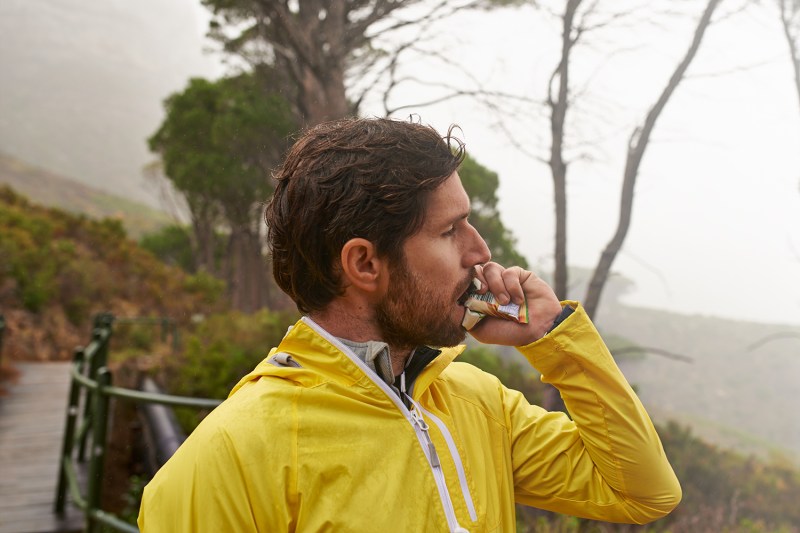
Warmer weather is here, and it’s finally time to dust off the hiking gear that’s been hibernating in the back of your closet all winter, and make some hiking snacks that will get you ready to hit the trails. From getting fresh air and exercise to enjoying scenic vistas, hiking is one of the best ways to get outdoors and enjoy nature. But, whether you’re taking on one of the most physically challenging hikes in the U.S. or embarking on a short and simple day hike, it’s important to be prepared with the right equipment — and that includes the best hiking snacks.
If you’re keeping your hike relatively short, there’s no need to reach for the dehydrated meals. What you do want are snacks that won’t spoil, don’t take up a ton of space in your backpack, and help you stay energized and feel good all day long. That means you’ll want a mix of carbohydrates and protein, both of which your body needs to perform at its best during the hike and recover properly once you’re done.
So, stuff your pack with these nutritious, tasty snacks (plus plenty of water, of course), and you’ll be ready to hit the trail. Just remember to pack out any wrappers or other trash you brought with you!
Trail mix

Arguably the most iconic hiking snack of all time, no list of the best snacks to take on a hike would be complete without trail mix. Who among us wasn’t given a Ziplock bag of trail mix when going on childhood hikes, only to rifle through it and pick out the M&Ms? While the exact types of nuts and dried fruits can vary, trail mix is typically made with a combination of nuts (like cashews and almonds), dried fruit (like raisins and bananas), and, of course, something sweet like M&Ms.
Not only does the mix of salty and sweet really hit the spot when you’re
Granola and granola bars

Another staple of the hiker’s diet, a granola bar delivers crunch, flavor, and filling calories. Typically made with rolled oats combined with sweeteners like honey or sugar and additional ingredients like nuts or dried fruits that are then baked into bars, granola is rich in protein, carbohydrates, fiber, and other nutrients like iron and vitamin E. Because it’s shelf-stable and will keep for a long time, hikers don’t have to worry about it spoiling on long hikes, and the clumped-up oats make it easy to snack on.
Just be mindful of the sugar content in store-bought granola bars.While sugar can be a useful source of quick energy on a hike, make sure it’s balanced with other important nutrients, like the protein and fiber we mentioned. Nature Valley, Kashi, and KIND make tasty granola bars to consider. Sure, the granola may crumble a bit, but that’s part of the fun.
Fruit

Either in fresh or dried form, fruits are a healthy choice for a
Plus, the natural sugars of fresh or dried fruits will give you an energy boost, while the fiber in them helps counteract high spikes in blood sugar, resulting in more sustained energy. It should be noted, though, that if you bring oranges or bananas, you shouldn’t discard the peels on the trail. Although they will biodegrade eventually, that process can take years and potentially be harmful to local biodiversity, so do the right thing and pack out your orange and banana peels for proper composting.
Nuts

Another no-brainer
You can stick to staples like almonds, pistachios, or walnuts, or mix it up and bring a mixed bag for varied texture and taste. Just don’t litter the shells on the trail as you go. Although they are technically natural, the Leave No Trace Center For Outdoor Ethics lists nutshells as unnatural litter since “they can take years to decompose” and can attract wildlife.
Nut butters

Full of protein and delicious to boot, nut butters are on the rise as a must-pack for hikes. Available in easy-to-carry packets that you can either squeeze directly into your mouth or add to a slice of apple from brands like RXBAR and Justin’s, nut butter can be a convenient, low-maintenance
Hikers have their choice of cashew, almond, walnut, and more, and many brands add other all-natural ingredients like seeds or, in the case of RXBAR, egg white for protein, to their butters to boost the benefits. Some also come in fun flavors like chocolate or coffee.
Protein and energy bars

Another iconic sight on trails around the world, energy and protein bars give hikers boosts of protein and carbohydrates in small, easy-to-carry packages. Few things feel as much like “hiking” as tearing open an energy bar at the summit of a hike and eating it while taking in the view. While there are plenty of health benefits to energy bars, like the high protein, in the past, these processed bars were also sometimes very high in sugar and artificial ingredients.
The industry is trending away from that now though, offering hikers more options for all-natural, organic energy bars made with simple ingredients. Many also come in delicious flavors like chocolate or peanut butter. Some of the most popular energy bar brands for hikers include CLIF, Kind, and RXBAR.
Jerky

For something chewy and high in protein that isn’t a vegetable or fruit, grab some jerky for the trail. The protein will help keep your muscles in peak
Jerky also comes in lots of fun flavors like teriyaki or chipotle to keep things spicy on the trail. Just be wary of the sodium content. Jerkies tend to be high in sodium, and you can quickly exceed the daily recommended amount (no more than 2,300 mg per day) if you aren’t mindful of your other food choices throughout the day. To control the ingredients completely, you can make your own
Is it important to have salty snacks when hiking?
It actually is, because when you’re



